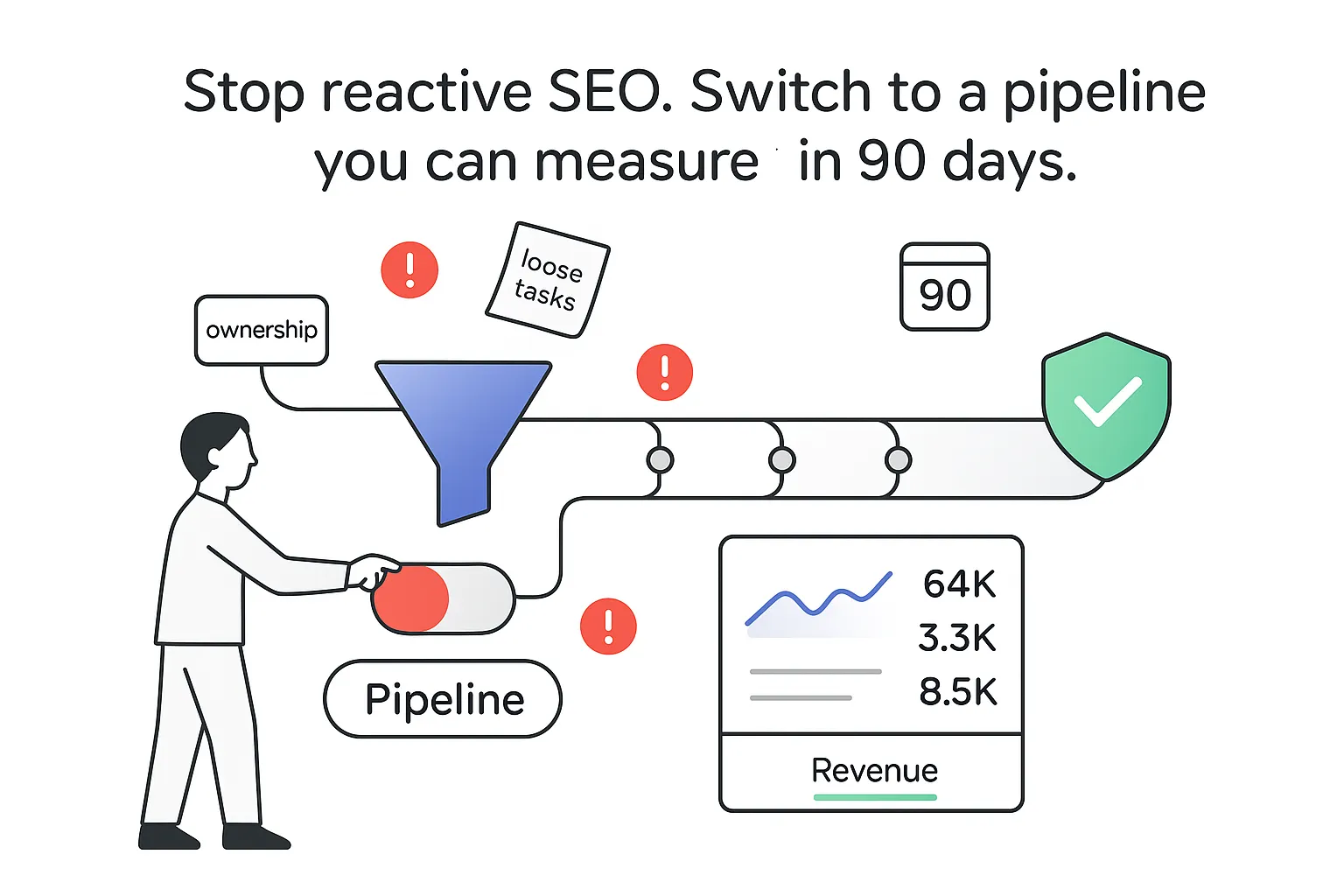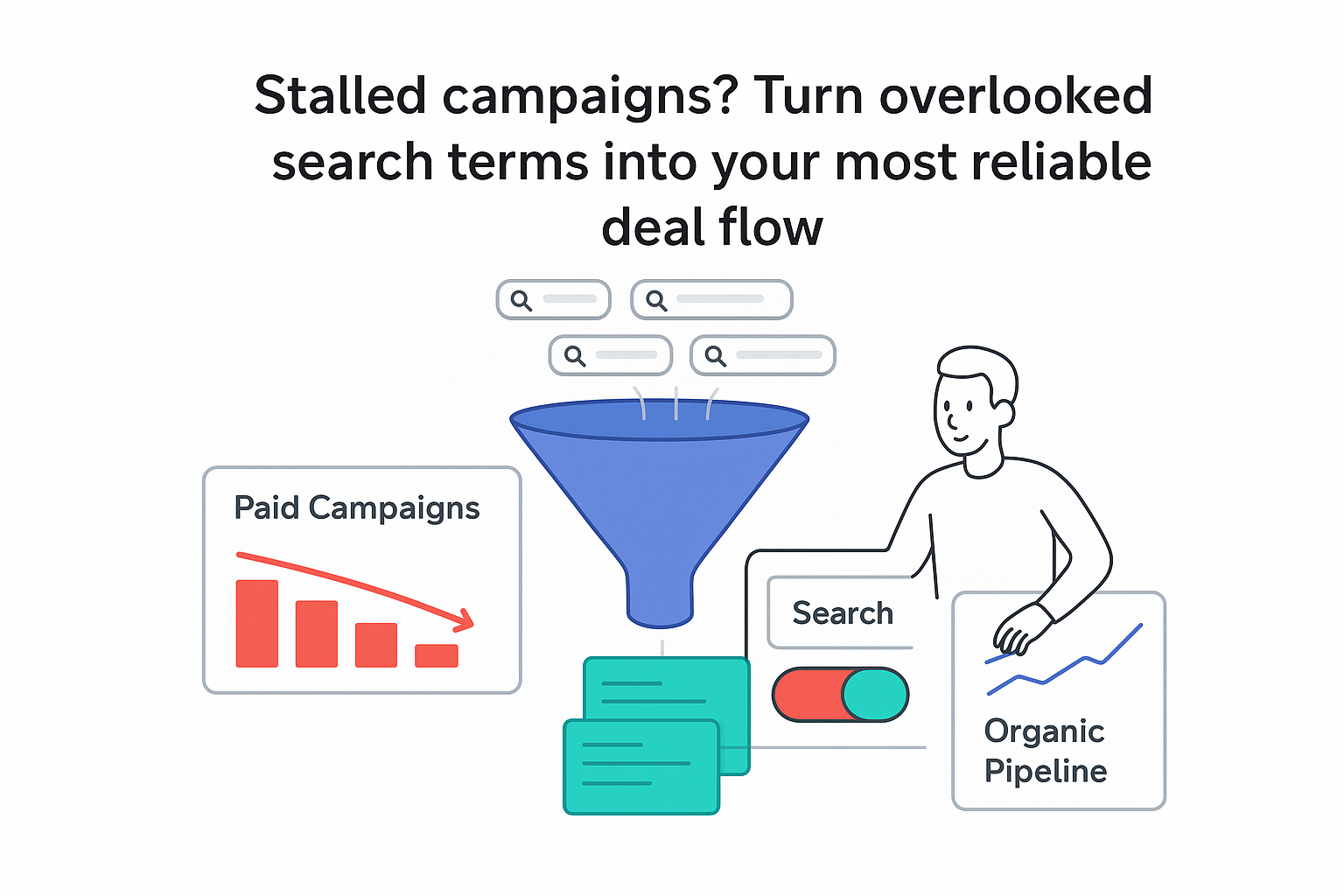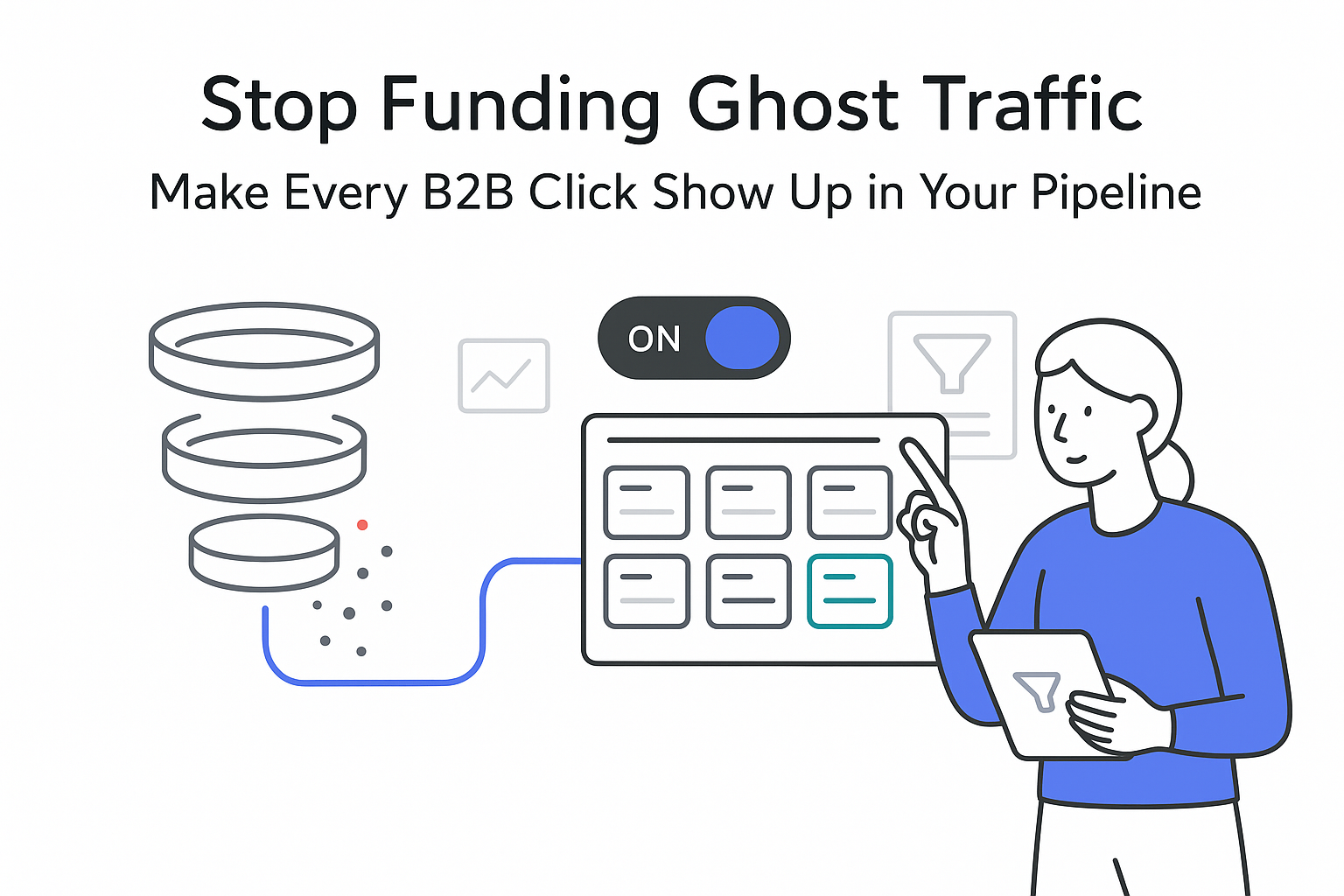I want growth without babysitting the channel. I want to see where money goes, when results land, and how much pipeline came from organic. That’s fair. Most B2B service leaders I speak with aren’t anti-SEO; they’re anti-mystery. The fix isn’t hacks. It’s clear ownership, linked systems, and a repeatable playbook that holds up quarter after quarter.
B2B SEO for service companies: the root problem of unreliable outcomes
If you’ve been burned before, you’re not alone. Past partners promised page-one rankings, then delivered thin content and vague reports. KPIs didn’t match revenue. Tracking broke. Everyone waited for results that never showed. The real issue is operational SEO risk. When the program isn’t tied to pipeline, governed by shared rules, and audited for quality, outcomes drift and trust fades.
Quick moves I make right now
- I kill vanity metrics. I pick two that pay the bills: sales-qualified leads and pipeline value touched by organic.
- I set a single source of truth. One analytics platform for traffic, one search performance view for visibility, and the CRM for revenue attribution. If numbers don’t agree, they don’t ship.
- I stop the content spray. I map every page to a stage and an intent. If it can’t influence a meeting, it waits.
- I fix crawl traps and slow templates. If search engines can’t fetch it fast, prospects won’t either.
- I require edit logs on high-intent pages. No silent changes, ever.
When I make those changes early, momentum builds and the channel stops feeling like guesswork.
Targets for what good looks like
I treat these ranges as starting guardrails, then calibrate to your market, ACV, and cycle length.
- Traffic quality: 35–55% of organic sessions from the right countries and devices, with 2–3 pages per session on bottom-of-funnel visits.
- Pipeline influence: 25–45% of new opportunities touched by organic within 90 days of first touch in sales cycles over 60 days.
- Cost per SQL: commonly 40–70% lower than paid search after month six, assuming technical debt is cleared in the first 60 days. These are directional; competition and deal size can widen the range.
Where ROI usually leaks
- Misaligned KPIs. Rankings rise for queries that never create meetings.
- Thin or generic content. It ranks, then fails to convert real buyers.
- Broken analytics. Incomplete consent capture, missing UTMs, or CRM fields that don’t sync.
- Weak intent control. Pages compete with each other and cannibalize gains.
- AI with no human review. Fast production, slow trust, and risks like AI hallucinations and indications of biases.
Close these gaps and B2B SEO for service companies stops feeling like a gamble and starts acting like a dependable channel.
Accountability in B2B lead generation
Accountability is a design choice. I make it explicit.
Ownership model
- SLAs: critical technical issues resolved within 10 business days, medium within 20, low on a quarterly cadence. Content turnaround within 15 business days from brief to draft unless otherwise agreed.
- Reporting cadence: weekly highlights, monthly deep dives, and quarterly business reviews that tie directly to revenue.
- Decision rights: who approves briefs, who can change goals, who greenlights technical deployments, who owns CRM fields. I write it down.
A KPI scorecard tied to revenue
- Pipeline influenced by organic: target by segment and ACV; trend line shows reach into larger deals.
- SQLs from organic: target by market, with acceptance rate and disqualification reasons.
- ACV by entry page: I track which pages attract the largest accounts.
- Conversion rates: visit-to-demo request, demo-to-SQL, SQL-to-opportunity, opportunity-to-closed-won.
- Content velocity and coverage: share of high-intent topics completed this quarter, mapped to stages.
Governance that keeps it clean
- One view of truth pulled from analytics, search performance, and CRM.
- An experiments backlog with hypotheses, owners, and clear stop rules before tests start.
- Change logs for high-intent pages, templates, and tracking. If it changed, it’s recorded.
When contracts are transparent and data access is shared, lead generation stops leaning on trust and starts leaning on proof.
SEO strategy: a multi-layered approach
I build programs as four interlocking layers: technical fit so search engines and buyers can move freely; content that meets real questions across the buying path; authority earned where it counts; and conversion that turns attention into meetings. One layer alone can look good in a slide. Together, they move revenue. The framework must match your ICPs and sales enablement plan. Marketing feeds sales, sales feedback refines the system, then the loop continues. AI can assist with speed and coverage, but people hold the pen on quality and risk.
Technical foundations that remove friction (first 30 days prioritize)
- Priority 1: crawlability and indexation (robots directives, canonicals, noindex rules), clean site architecture (hub-and-spoke for services, industries, use cases), Core Web Vitals on key templates (faster LCP, stable CLS, reduced JS), analytics hygiene (events configured, consent capture working, standardized UTMs, verified properties).
- Priority 2: structured data (organization, product/service, FAQ, breadcrumbs where appropriate), log-based crawl diagnostics to reduce wasted crawl, correct internationalization (including hreflang) if applicable.
- Priority 3: image compression and lazy loading on non-critical assets, sensible 404 and redirect rules to clear legacy clutter, staging QA so releases never break tracking.
Content that attracts decision makers (and earns the second scroll)
- Plan for the full journey: problem framing (market shifts, risk of inaction, plain definitions), solution design (architectures, integration notes, timelines, trade-offs), vendor selection (pricing models, comparisons, security FAQs, implementation details), and proof (case studies, ROI narratives, field notes from customer success).
- Bias toward bottom-of-funnel assets. Publish pricing guidance even if ranges vary. Outline packages by profile. Create comparisons that mirror buying criteria, not feature laundry lists. Use real screenshots and named processes when allowed.
- On AI and trust: I let AI assist with outlines and clustering, then have humans fact-check, add a point of view, and validate terminology with sales. I add E-E-A-T safeguards: real bylines, reputable references, and update dates. When useful, I cite credible risks like AI hallucinations and indications of biases so stakeholders understand why human oversight matters.
- Tie topics to demand units: I map CFO, COO, and VP Ops questions across stages. If a page cannot sway a meeting or help a champion win an internal thread, it’s nice-to-have, not need-to-have. I pair each top-of-funnel piece with a bottom-of-funnel counterpart so visibility can convert.
Authority that favors quality over volume
- Sources that travel well: original data cuts and industry insights that journalists and trade publications cite; partner co-marketing (integrations, joint content, shared case studies) with clean attribution; niche associations and vetted review profiles; thoughtful syndication with canonical links.
- Risk controls: no private blog networks or paid links; a disavow policy for obvious spam; I track referring domains by topic and authority threshold, not just counts. A handful of right-fit links beats a sea of weak mentions.
SEO ROI: the path forward for predictable growth
Predictability comes from a simple model, measured the same way every month. No hero charts - just inputs and outputs I can explain to a board in five minutes.
A plain ROI model
- Investment: external support, internal time, and development effort.
- Traffic-to-pipeline math: sessions-to-demo rate, demo-to-SQL rate, SQL-to-opportunity rate, win rate. I multiply through by ACV for expected value.
- CAC trend: total investment divided by closed-won deals attributed to organic, compared quarter over quarter.
Example numbers (illustrative)
- Months 1–3: 8,000 organic sessions; 1.5% visit-to-demo; 30% demo-to-SQL; 25% SQL-to-opportunity; 20% win rate; 25k ACV. Expected monthly value around 45k.
- Months 6–9 after technical cleanup and BOFU content: 12,000 sessions; 2.8% visit-to-demo; 40% demo-to-SQL; 30% SQL-to-opportunity; 22% win rate; 28k ACV. Expected monthly value around 111k with cost per SQL roughly halved.
Trend lines I look for
- A rising share of pipeline touched by organic on larger deals.
- Falling time to first organic opportunity after new content launches.
- Stable or rising conversion rates as traffic grows, which signals intent control rather than random visibility.
I keep the model transparent by pulling analytics, search, and CRM data into one executive view with locked definitions, so the numbers match from board deck to daily standup.
SEO timeline and reporting that build trust
I set expectations upfront so no one guesses.
What happens when
- Days 1–30: technical audit and fixes for critical issues; analytics cleanup; keyword and intent mapping; briefs for the first BOFU pages.
- Days 31–60: publish the BOFU set; start TOFU and MOFU support pieces; begin link outreach; lock in dashboard views. First quarterly review.
- Days 61–90: expand BOFU to all core services or industries; deploy structured data and performance improvements on key templates; ship the first partner co-marketing asset.
Milestones you should see
- 3 months: leading indicators move. Index coverage cleans up; performance improves on key templates; first assist touches appear in the CRM.
- 6 months: BOFU pages rank on page one for a cluster of intent terms. Demo requests from organic begin to compound. Cost per SQL trends down.
- 12 months: a repeatable content and authority cadence is running. Organic becomes a primary source of qualified pipeline. Forecast confidence rises.
Reporting view and definitions
- Analytics for sessions, events, and conversion flows with consent capture configured correctly.
- Search performance reports for queries, coverage, and enhancements.
- CRM attribution for first-touch, last-touch, and multi-touch where possible.
- Call and meeting capture if sales cycles rely on phone conversations.
- Behavior analytics (heatmaps or session replays) on key pages to spot friction.
Automated dashboards show what happened. Human analysis explains why and what to change next. I pair both so leadership gets signal without drowning in charts.
Key terms that keep conversations crisp
- MQL: a marketing lead that meets a fit-and-interest rule agreed with sales.
- SQL: a sales-accepted lead ready for a real conversation.
- ACV: average contract value for an initial deal.
- LTV: lifetime value, or the revenue expected over time.
- CVR: conversion rate between two stages (for example, visit to demo).
- CTR: click-through rate for a search result.
Here’s the calm, realistic view. SEO is not instant, and yes, quick wins exist. Short content sprints can move the needle when they target the right pages. Technical fixes can deliver gains within weeks if crawling was blocked. Authority takes longer, yet smart partnerships speed it up. The tension is real and manageable when I agree on a plan, track what matters, and give the work enough runway. If I solve for ownership first, put a layered program in place, reduce risk with governance and clean tracking, give AI a seat while humans keep the keys, and measure against pipeline - not pageviews - the guesswork drains away and the numbers start to tell a steady story.







.svg)